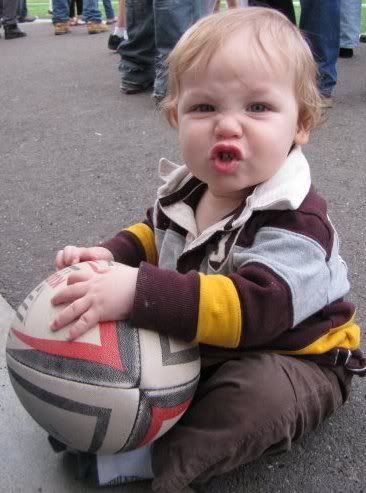 |
| Ruff! |
I can’t believe I haven’t read about this somewhere else. I mean really, with all the parenting stuff out in the world I can’t believe no one has mentioned the “Puppy Phase.” Perhaps I am the first to have the perfect storm of Chihuahuas and child under one roof but it’s so clear to me I can’t believe it’s not already a thing.
Sorry, what the hell am I talking about? I’m talking about the never ending need to dissect every phase of a baby’s development and give it a cute name. I seem to remember that when my brother was a baby he was a “baby,” then a “toddler, “ then a “kid.” The third phase lasted until he was a “teenager.” Nice, simple, four steps to adulthood. Not anymore. It seems my son has been a “newborn”, an “infant”, a “pre-crawler”, a “crawler”, and a “cruiser.” Soon he will be a "waddler," then a "toddler.” I’m sure I’m missing some intermediate labels from that list. Still, there’s seven stages before he can eat with utensils. It’s madness. And, as one who sees madness and endeavors to heighten it to a truly absurd levels I am now identifying, codifying, and proposing a new developmental stage, the “Puppy Phase,” which slots between “crawler” and “cruiser.”
As you may be able to guess the Puppy Phase is based on a child’s similarity, at this phase, to a dog. During the puppy phase the child exhibits many dog-like qualities. For example, many babies this age do not have the lip dexterity to smooch the way most humans are used to. Instead they show affection with a type of open mouthed slobbering, much like being licked by a small St. Bernard. This, along with babies tendency to chew everything they see, is probably the least noticeable aspect of the puppy phase, which is largely centered around mobility.
When my son learned to crawl it was a joyous occasion for all of us. For him he was now relieved of the frustration he had found when he learned to throw his toys weeks earlier than he was able to retrieve them. For me it meant we could now play fetch, which was way more fun than playing sit still. Usually fetch involved my son or I throwing a ball or other toy and my son crawling off to fetch it and then either throw it again himself or bring it back to me; in his mouth. The puppy phase started to show when he decided he wanted go visit his mother in the dining room, clamped a small novelty Frisbee between his teeth and headed off.
Children this age also display other mobility related puppy behaviors. For example a pre-lingual child in the puppy phase will careen off towards the door emitting shrieks whenever he hears the mail slot open or the lock turn. The child will sit dutifully at the feet of anyone who seems to be eating. If they are not fed (or if they just want attention) they will then raise up on their hind legs (like a little Rory Calhoun) and emote until they are fed, pet, or cuddled.
Other behaviors associated with the puppy phase include following you around the house, the afore mentioned desire to chew everything, and the need to curb occasional biting. The puppy phase generally lasts a few weeks, can overlap with the “cruising” phase, and ends when the child starts standing or walking.


Playing fetch...I love that one. Unfortunately my son, now 13, is no longer able to fetch anything for himself due primarily to him being squarely in the Lazy Phase.
ReplyDelete